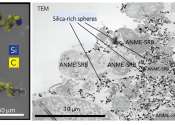'Kinks' in tiny chains reveal Brownian rotation
(PhysOrg.com) -- Rice University researchers have created a method to measure the axial rotation of tiny rods. The technique detailed in a paper by Sibani Lisa Biswal and her colleagues appears this month in the journal Physical ...








